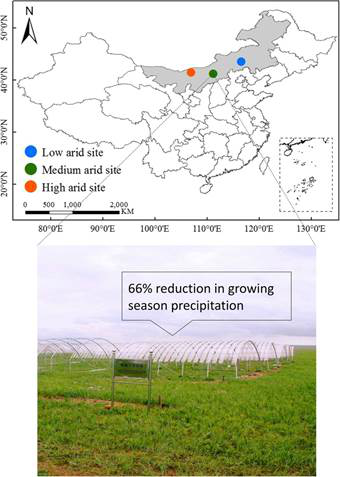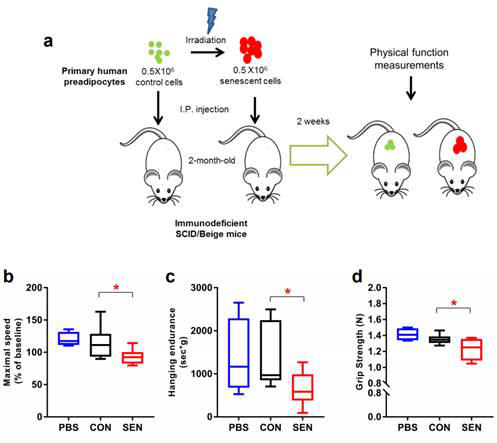新聞動態(tài)
News
土壤中的活性鐵氧化物采用 DCB 還原溶解提取,提取過程中釋放的有機碳為鐵氧化物結合態(tài)有機碳。具體方法如下:稱取過0.25mm篩的土樣0.5000g于50mL帶蓋離心管中,先加入30mL提取劑(0.27mol/L檸檬酸三鈉和0.11mol/L碳酸氫鈉混合溶液,pH=7.3),80℃水浴預熱15分鐘,準確加入0.5g連二亞硫酸鈉粉末,保溫15分鐘(期間不斷振蕩),然后4000g離心力下離心20 分鐘。將上清液倒于100mL容量瓶中,向固體殘渣中加入5mL 超純水,搖勻,離心,上清液倒入對應的容量瓶,清洗步驟重復五次,將最后的殘渣冷凍干燥、研磨。在上述的提取實驗中需進行對照實驗以校正水浴加熱過程中水溶性有機碳的釋放。在對照實驗中,向土壤樣品中加入 30mL 提取液(1.6mol/L氯化鈉和0.11mol/L碳酸氫鈉混合液,pH=7.3),80℃ 水浴預熱 15 分鐘,加入0.44g氯化鈉固體,繼續(xù)加熱并振蕩15分鐘,4000g離心20分鐘,殘渣用5mL超純水清洗五次后,冷凍干燥后研磨。最后,將上述經DCB 處理和NaCl處理后的殘渣按元素分析儀方法測定其中的有機碳、全氮比值。鐵氧化物結合態(tài)有機碳=NaCl處理殘渣碳含量-DCB處理殘渣碳含量# 栢暉 #—特色檢測指標—土壤、植物酶活檢測氨基糖、木質素、PLFA磷組分、有機酸、有機氮組分微生物量碳氮磷、同位素等其他土壤、植物、水...
發(fā)布時間:
2023
-
09
-
28
瀏覽次數:0
作者:
發(fā)布時間:
2018
-
11
-
17
點擊次數:
8
研究揭示干旱對植物群落的調控機制近日,中科院沈陽生態(tài)所生態(tài)計量化學團隊以植物群落養(yǎng)分計量為核心,基于草地樣帶調查和控制實驗的多源數據開展定量評估,闡釋了植物對長期和短期水分脅迫的響應機制。相關成果發(fā)表于《生態(tài)學》(Ecology)。在全球氣候變化背景下,內蒙古草原干旱強度和頻度呈多發(fā)趨勢。水分是該生態(tài)系統(tǒng)植物生存和繁衍的主要驅動因子,干旱事件將對草原生態(tài)系統(tǒng)結構和功能產生深遠影響。氮和磷是影響陸地生態(tài)系統(tǒng)植物生存、生長和繁殖的主要因子。因此,該團隊以群落養(yǎng)分計量為全新理念和視角,探究水分脅迫對生態(tài)系統(tǒng)結構和功能影響的內在機制和過程,厘清種內和種間的競爭作用關系對群落結構和動態(tài)的影響,旨在為理解草地退化機制、加快退化草地恢復提供參考。研究結果顯示,長期水分脅迫下,植物通過內穩(wěn)態(tài)機制提高養(yǎng)分濃度,增強群落的抵抗能力,物種周轉是該過程的主要影響因素,但在短期干旱條件下,群落養(yǎng)分對水分脅迫的響應更復雜。整體而言,群落氮濃度上升、磷濃度下降時,種內競爭和物種周轉共同影響該生態(tài)過程。此外,不同區(qū)域群落養(yǎng)分響應程度具有明顯差異。極度干旱地區(qū),植物群落養(yǎng)分抵御水分脅迫的能力最強,響應最遲緩。該團隊表示,未來研究應建立大型聯網干旱實驗平臺,緊密結合控制實驗和自然梯度實驗,提高實驗結果的準確性和有效性,為建立草地生態(tài)系統(tǒng)自然評估體系提供重要理論依據。(來源:中國科學報唐鳳) Differential responses of canopy nutrients to experimental drought along a natural aridity gradient Abstract The allocation and stoichiometry of plant nutrients in leaves reflect fundamental ecosystem processes, biotic interactions, and environmental drivers such as water availability. Climate change will lead to increases in drought severity and frequency, but how canopy nutrients will respond to drought, and how these responses may vary with community composition along aridity gradient...
作者:
發(fā)布時間:
2018
-
11
-
12
點擊次數:
2
蘋果皮提取物可延緩衰老進程“一天一蘋果,醫(yī)生遠離你”是一句耳熟能詳的健康諺語。不過,吃蘋果的最好方法是帶皮吃。據最新一期《自然—醫(yī)學》(Nature Medicine)報道,美國科研人員發(fā)現,達沙替尼(一種白血病藥物)和槲皮素(一種來自蘋果皮的提取物)的組合可使老年小鼠的壽命延長36%。衰老細胞通常在60多歲時出現在人體內,而在肥胖人群或慢性病患者體內出現得更早。這些異常細胞處于衰退狀態(tài),但其又不甘于死亡。有人認為,衰老細胞本身會催化衰老進程。美國梅奧診所詹姆斯·柯克蘭領導的研究團隊證明,情況確實如此。當研究人員向6個月大的小鼠注射少量衰老細胞時,它們的速度、耐力和力量在幾周內下降了20%至50%,差不多是典型2歲老年小鼠的水平。為了阻斷衰老細胞的影響,研究團隊選擇了達沙替尼和槲皮素的組合,因為兩者都會干擾衰老細胞避免死亡的方式。當研究團隊將組合藥物給予因注入衰老細胞而老化的幼鼠時,這些小鼠所失去的身體能力在兩周內恢復了50%至100%。當研究團隊將藥物給予年齡在24至27個月間的老年小鼠時,這些小鼠的速度、耐力和力量提高了30%到100%,而且它們的剩余壽命要比那些未給藥老年小鼠長36%。(來源:科技日報 馮衛(wèi)東) Senolytics improve physical function and increase lifespan in old age Abstract Physical function declines in old age, portending disability, increased health expenditures, and mortality. Cellular senescence, leading to tissue dysfunction, may contribute to these consequences of aging, but whether senescence can directly drive age-related pathology and be therapeutically targeted is still unclear. Here we demonstrate that transplanting relatively small numbers of senescent cells into young mice is sufficient to cause persistent physical dysfunctio...
作者:
日本 農業(yè)和食品產業(yè)技術綜合研究機構 野田尚信
發(fā)布時間:
2018
-
11
-
11
點擊次數:
2
摘要 : 2017年7月26日,國際頂尖學術期刊《Science》旗下《Science Advances》雜志上在線發(fā)表了日本農業(yè)和食品產業(yè)技術綜合研究機構野田尚信等人利用轉基因技術第一次在世界上培育出一種“真正藍色”的菊花。2017年7月26日,國際頂尖學術期刊《Science》旗下《Science Advances》雜志上在線發(fā)表了日本農業(yè)和食品產業(yè)技術綜合研究機構野田尚信等人利用轉基因技術第一次在世界上培育出一種“真正藍色”的菊花。藍色花卉給人高貴、冷艷的感覺,但人們常見的觀賞花卉卻少見藍色。自然界中的天然藍色花卉通常產生被稱為花翠素的藍色色素。但此前研究發(fā)現,利用人工方法讓常見觀賞花卉含有花翠素,培育出的不是藍色花,而是紫色或紫羅蘭色花。野田尚信等人此次的新方法涉及兩種基因。首先,他們把藍色風鈴草的一種基因“插”入菊花,修改花翠素讓花朵呈紫色;然后,他們“插”入來自蝶豆花的第二種基因,這種基因給花翠素增加了一種糖分子,結果菊花就變成了“真正的藍色”。“這是此前從未報告過的發(fā)現,”研究人員在論文中寫道,“這種簡單方法是培育各種觀賞植物開藍色花的一種很有前景的途徑。”原文鏈接:Generation of blue chrysanthemums by anthocyanin B-ring hydroxylation and glucosylation and its coloration mechanism原文摘要:Various colored cultivars of ornamental flowers have been bred by hybridization and mutation breeding; however, the generation of blue flowers for major cut flower plants, such as roses, chrysanthemums, and carnations, has not been achieved by conventional breeding or genetic engineering. Most blue-hued flowers contain delphinidin-based anthocyanins; therefore, delphinidin-producing carnation, rose, and chrysanthemum flowers have been generated by overexpression of the ge...
 微信公眾號
微信公眾號 檢測咨詢熱線
檢測咨詢熱線
地址:四川省成都市成華區(qū)成宏路72號-四川檢驗檢測創(chuàng)新科技園2號樓4層
湖南省長沙市芙蓉區(qū)雄天路98號廣發(fā)隆平創(chuàng)業(yè)園2棟6002
湖南省長沙市芙蓉區(qū)雄天路98號廣發(fā)隆平創(chuàng)業(yè)園2棟6002
電話:028 8525 3068
傳真:+86 0755-2788 8009
Copyright ?2005 - 2013 成都栢暉生物科技有限公司
犀牛云提供企業(yè)云服務



















